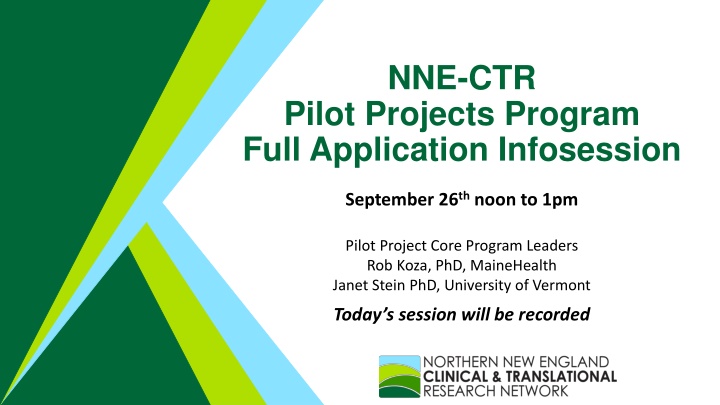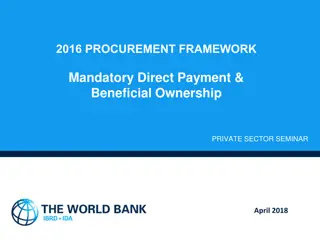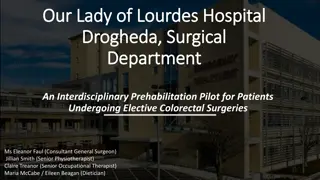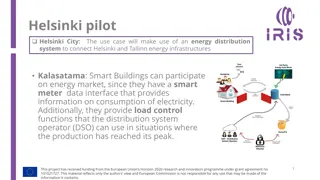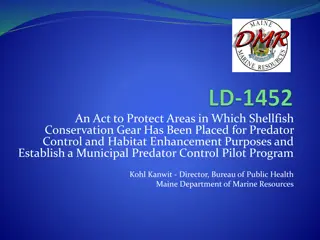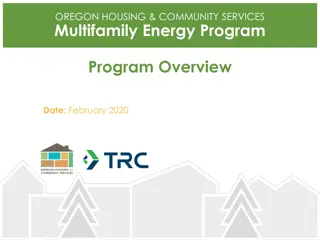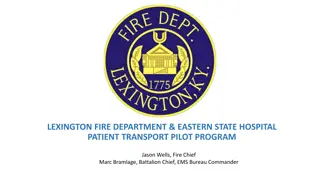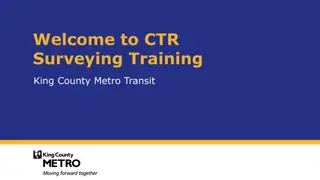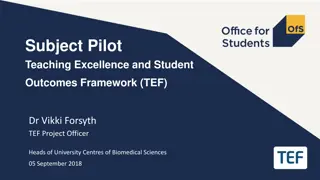NNE-CTR Pilot Projects Program Overview
Today's session covers the NNE-CTR Pilot Projects Program, including the introduction to the team, timeline, application tips, review process, funding mechanism, and contacts for assistance. The program aims to support regionally relevant research and collaborations between researchers and communities for one-year projects funded by NIGMS.
Uploaded on Mar 17, 2025 | 0 Views
Download Presentation

Please find below an Image/Link to download the presentation.
The content on the website is provided AS IS for your information and personal use only. It may not be sold, licensed, or shared on other websites without obtaining consent from the author.If you encounter any issues during the download, it is possible that the publisher has removed the file from their server.
You are allowed to download the files provided on this website for personal or commercial use, subject to the condition that they are used lawfully. All files are the property of their respective owners.
The content on the website is provided AS IS for your information and personal use only. It may not be sold, licensed, or shared on other websites without obtaining consent from the author.
E N D
Presentation Transcript
NNE-CTR Pilot Projects Program Full Application Infosession September 26thnoon to 1pm Pilot Project Core Program Leaders Rob Koza, PhD, MaineHealth Janet Stein PhD, University of Vermont Today s session will be recorded
Agenda: Todays Session will Cover Pilot Project Program Team Introductions Overview of PPP Brief Description on the NNE-CTR Cores Timeline Navigation Services Application Forms Tips for writing Research Strategy How to Submit Review Process Notification and JIT Phase Approvals Funding Mechanism We will take time for questions after each section Detailed instructions, submission forms and other guidance are located on our website by following the Application Materials and How-to Guides tab. https://www.med.uvm.edu/nne-ctr/funding/PPP/apply
Pilot Project Core Program Team Contacts Keep an eye out for communications from these people! Reach out, we re here to help! NNE-CTRPilot Project Core Program Leads: Rob Koza, PhD, MaineHealth Robert.Koza@mainehealth.org Janet Stein PhD, University of Vermont Janet.Stein@med.uvm.edu NNE-CTR Administrative Program Managers: Meredith Oestreicher, MaineHealth meredith.oestreicher@mainehealth.org Shelia Clifford-Bova, University of Vermont sheila.clifford-bova@med.uvm.edu NNE-CTR Grant Specialist: Michele Locker, MaineHealth michele.locker@mainehealth.org
Pilot Projects Program Introduction Conducted over a one-year duration Produce publishable results Provide preliminary data for an external grant application Direct costs of $40,000, regardless of the number of sites in the project Collaborations between IDeA-state investigators at the lead institutions (MaineHealth, University of Vermont) and/or partnering institutions/programs are encouraged Collaborations between basic/translational scientists and clinical investigators, and between population health scientists and community practitioners encouraged The NNE-CTR Pilot Projects Program is funded by the National Institute of General Medical Sciences (NIGMS) Clinical and Translational Research IDeA (CTR) Award
Our NNE-CTR Service Cores Administrative Core (Admin) provides the leadership and resources to support regionally relevant research Biostatistics, Epidemiology, & Research Design Core (BERD) provides expert guidance across the research process, from study design to analysis and reporting Community Engagement & Outreach Core (CEO) facilitates community-engaged research by connecting researchers and communities Professional Development Core (PDC) provides mentorship and professional development training for investigators and clinicians at any stage in their careers Translational Research Technologies Core (TRT) provides access to state-of-the-art research technologies Tracking & Evaluation Core (TEC) collects network-wide data on program activities, outcomes, and diversity to inform Administrative Core decision making
Proposal Submission Timeline November 1st: Full application submission deadline February 26th: Recommendations for Funding Announced June 15th: Regulatory approvals and other JIT materials due July: Intended Project Start Date Based on the funding cycle of the NNE-CTR parent grant Subject to regulatory and NIGMS approval Any Questions on Timeline? Next Up: Navigation
Navigation Services A Navigation consultation (at a minimum) is required to apply Navigation Services are provided by three cores: Biostatistics, Epidemiology, & Research Design Core Community Engagement and Outreach Core Professional Development Core Services are available at both MaineHealth and University of Vermont Institutions outside of MaineHealth or University of Vermont will use navigation services from their collaborating site at MH or UVM NNE CO-OP PCBRN applicants will use navigation services at MH or UVM based on the affiliation(s) of key personnel in their project team
Navigation: Research Navigators Research Navigators from the BERD and PDC cores help to translate project ideas into measurable research, including: Research Design Grant Preparation Assistance Manuscript and Presentation Preparation Assistance REDCap Support Data Collection & Management Data Analysis Data Visualization Compliance and Procedure IRB and IACUC approvals Policy and regulatory Procedures
Navigators: Community Engagement Community Engagement and Outreach Research Navigators from the CEO core facilitate and encourage research that engages communities, including: Conducting community needs assessments Connecting researchers, clinicians, and communities with shared interests Educating communities about clinical and translational research Educating researchers about community priorities Facilitating collaboration between communities & institutions Any questions about Navigation Services? Next Up: Application Forms
NIH Forms Section A Forms will be outlined in the following slides These 4 forms should be uploaded as one combined PDF Signed Cover Page Project summary, Relevance, Performance site Additional Project/Performance Site Locations only needed if more than two sites Senior/Key and Other Significant Contributors and human embryonic stem cells
Cover Page/Facepage Completed by the Pilot Project Lead s Institutional Official MaineHealth and UVM have slightly different processes, please review the FAQ for info on: Who signs this form What if the project has more than one site What your UEI number is We do not use a DUNS number
Project Summary, Relevance Performance Sites Project Summary: Describe the overall project, including aims and outcomes. Relevance: In no more than three sentences, briefly describe in lay language the impact of the project on public health. Project Performance Sites: The first site should be the site of the Project Lead. If there are collaborating sites, fill in for all collaborating sites (next slide) See FAQ for questions on UEI number
Additional Sites, only if Needed
Senior/Key Personnel List the Pilot Project Lead as senior/key, as well as Co-Leads at collaborating sites. Mentors or collaborators who are not giving measurable time should be listed as Other Significant Contributors. Project staff such as data analysts, technicians, research coordinators, and research assistants, are not senior key or significant contributors. They are listed and described in the budget and budget justification. Don t forget to check YES or NO to Embryonic Cells! Questions on NIH Forms? Next Up: Budget
Budget Use the budget template developed for the NNE-CTR Pilots to provide a detailed budget for each site, and a cumulative total Budget Justification from each site included in the budget template See FAQ for questions on who to go to for help with budget This is not a Navigator! Meredith (MH) or Sheila (UVM) can help point you in the right direction
Budget: Basic Guidelines Direct costs up to 40k Use your own federally negotiated indirect rate not to exceed 72% Personnel No salary support for Faculty members, including PPL Support for research coordinators, assistants, tech staff, stats, analysts etc. Travel: MUST be related to the conduct of the research Presentations and/or attendance at a conference is not allowed Equipment and Software: 3k cap on equipment, unless pre-approved, refer to instructions Consultants Supplies Other Meals for meetings outside of travel reimbursements for per diem meals are not allowable Questions on Budget? Next Up: Biosketch
Biosketch NIH Biographical Sketches of all Senior/Key Personnel in one combined PDF First biosketch in combined file should be Pilot Project Lead Current NIH format is required Instructions, template and example on our website Please be sure to follow these instructions and review example Pilot Project Lead needs an era commons ID if selected for funding Done by home institution Any questions on Biosketch? Next Up: Research Plan
Research Plan There is no form for this section as it is in narrative Use 11pt Arial font and inch margins Include the following in your Research Plan: Introduction (for resubmissions only) (1 page limit) Specific Aims (1 page limit) Research Strategy (6 page limit) References/Bibliography (no page limit)
Specific Aims One Page Limit State concisely the goals of the proposed research and summarize the expected outcome(s), including the impact that the results of the proposed research will exert on the research field(s) involved. List succinctly the specific objectives of the research proposed, e.g., to test a stated hypothesis, create a novel design, solve a specific problem, challenge an existing paradigm or clinical practice, address a critical barrier to progress in the field, or develop new technology.
Research Strategy Six page limit, include: Significance and Background literature review, premise, importance of subject Hypotheses and Impact Innovation Statement Approach to include the study design for each aim with rationale and method, Data collection method and plan for analysis (assays, statistical methods, bioinformatics). Outcomes and Future Directions. Bibliography/References NOT counted in 6 page limit
Research Plan: General Tips Read all the instructions carefully for application guidelines Do not exceed the page limit nor use small font or narrow margins Arial 11 pt; 0.5 inch margins There should be no page numbers, headers or footers Use basic English and avoid jargon Make sure your prose is organized and clear without typographical errors Include section headings and breaks in the writing Repeat important points at several places in the application Include well designed and well-labeled flow diagrams, charts, and figures Make sure your citations are complete Make sure all acronyms are spelled out when used initially Do not put information in the wrong sections
Research Plan: General Tips Continued Have an outside reader review the application for clarity and consistency Your goal is to get your audience excited about your research Let your enthusiasm be reflected in your proposal Reviewers, will be inherently skeptical and may include experts in your field, or individuals who are smart but know little about your particular field Be explicit! Never assume that your reviewers will intrinsically appreciate or understand what you intend More on the review process coming up Questions on Research Plan? Next Up: Human Subjects & Clinical Trials
Human Subjects & Clinical Trials Human Subjects and Clinical Trials form, if applicable Template provided Detailed Instructions and Tip Sheet provided on the website The format of this tip sheet will look different from the template we use, but it is the same information being gathered
Human Subjects & Clinical Trials Tips USE YOUR NAVIGATOR TO HELP! Is it considered human subjects? if using de-identified specimens not collected for the study and investigators cannot know the identity, it may NOT be considered research with human subjects (get determination from IRB) a justification must be included. Is it exempt? Which exemption? Navigator to help and applicant to ask IRB prior to submission Exemption must be justified
Human Subjects & Clinical Trials Tips Continued Clinical Trials If you have answered yes to all four clinical trial questions Additional terms that are included in the NOA if funded Pilot Lead has additional responsibilities Sections 1-4 to be filled out
Human Subjects & Clinical Trials Tips Continued Single IRB Required when more than one site is conducting the same protocol and research is NOT exempt; one IRB must be designated to review/approve for all sites. Inclusion Enrollment Table or Planned Enrollment Table Required (except if Exemption 4) Must break down gender and ethnicity estimates Description of risks and protection measures Inclusion of all ages, women, minorities Questions on Human Subjects or Clinical Trials? Next Up: Vertebrate Animals
Vertebrate Animals If your project proposes the use of vertebrate animals No page limit Please include a header Use of Vertebrate Animals Address the following four points Description of Procedures Justification Minimization of Pain and Distress Euthanasia Detailed guidance on how to address these four points are in our Instructions
Data Sharing Plan NIH requires the sharing of scientific data In 1-2 pages, describe your data-sharing plan, including: Type and amount of data to be shared Related tools or software needed to access the data (if any) Standards to be applied to the data Data Access, and Associated Timelines Choose a repository for your data Timeline: must be shared at publication or end of project period Oversight of the plan (NOTE: NNE-CTR leadership will provide oversight) Distribution and Reuse of data
Data Sharing Plan Continued IMPORTANT NOTES: Repositories: The instructions provide a link for information on repositories available; identifying a repository is a key requirement Generation of Genomic Data: If your project includes generation of genomic data, there are different and specific guidelines -- see link in instructions. Justification for not sharing data: Only legal and ethical justifications will be considered. See link to instructions. If a project is small in scope, data must still be shared. Questions on Data Sharing? Next Up: Letters of Support
Letters of Support Optional May include letters from: Hospital or Practice Group Leader Dean Chair Significant Contributor Consultant Any Personnel listed in budget, project leads and co-leads do NOT need to provide LOS
Additional Sign Offs and Checklist Collaborating Site Assurances Additional sites Institutional Official sign off PI (PPL) Attestation states your agreement to: Accept responsibility for scientific conduct of the project Provide the required progress reports Comply with the NNE-CTR terms and conditions outlined in the request for applications. Any publication, poster or presentation resulting from this research project will cite the NNE-CTR award U54GM115516 and comply with the NIH Public Access Policy. Checklist Indicates all sections are complete and uploaded
How to submit Use the individual/unique link sent via REDCap Upload All sections A-H as PDFs in the appropriate fields Follow the instructions for what to include in each section Please use Required Naming Conventions! Questions on How to Submit? Next Up: Review Process and Criteria
Review Committee Applications will be reviewed by a Pilot Project Program Review Committee based on NIH scoring criteria Reviewers are within the NNE-CTR network from Maine, Vermont and collaborating health network and partner organizations Each application will be assigned two to three reviewers Review Committee will meet in January to discuss applications
Review Criteria (A) Significance Investigators Innovation Approach Human Subjects/Vertebrate Animals/Biohazards/can affect this criteria this score Environment
Review Criteria (B) Project is clinical or translational in nature Basic research will only be considered if mechanisms are being pursued that relate to the diagnosis, prognosis, or targeting of disease and the translational nature is clearly justified Responsiveness to addressing health and health care challenges in NNE communities Scientific rigor of the experimental design, including plans for data/statistical analysis Use of core resources available through NNE-CTR Innovation and significance Project environment, including facilities and adequacy of patient population Identification of mentorship and guidance for development and pursuit of pilot project Potential of the project to provide credentials for external funding. Adequacy of human subjects protections and/or vertebrate animal sections Questions on Review Process and Criteria? Next Up: Notifications, Approvals and Funding Mechanism
Notification and Just in Time (JIT) Phase All applicants will receive copies of their reviews If your project has been recommended for funding This is not a commitment to funding Notification will Include an Administrative Review Any Requested Revisions Regulatory approvals and human subjects certifications will be due by specific date Continue to use navigators as needed
Approvals After JIT documents have been submitted and accepted Approvals Needed from: External Advisory Committee (EAC) NIGMS final approval Project work may start after NIGMS approval is received NO PRE-SPENDING!
Funding Mechanism Award letter sent to PPL within one week upon notification of NIGMS approval Please review award letter carefully Subcontract to follow (if applicable) Operational Kick Off Meeting Scheduled
Final Questions? Final Questions? Thank you for joining, and good luck on your proposal! NNE-CTRPilot Project Core Program Leads: Rob Koza, PhD, MaineHealth Robert.Koza@mainehealth.org Janet Stein PhD, University of Vermont Janet.Stein@med.uvm.edu NNE-CTR Administrative Program Managers: Meredith Oestreicher, MaineHealth meredith.oestreicher@mainehealth.org Shelia Clifford-Bova, University of Vermont sheila.clifford-bova@med.uvm.edu NNE-CTR Grant Specialist: Michele Locker, MaineHealth michele.locker@mainehealth.org
